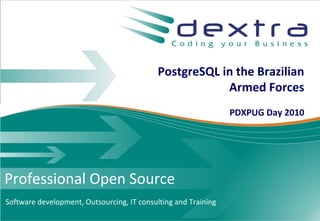Pg in-the-brazilian-armed-forces-presentation
- 1. PostgreSQL in the Brazilian Armed Forces PDXPUG Day 2010 Professional Open Source Software development, Outsourcing, IT consulting and Training
- 2. Agenda • Free/Open source software and Brazil • PostgreSQL in Army • PostgreSQL in Air Force
- 3. Elephants and Armed Forces
- 4. FOSS and Brazil • Wide use in companies and government – Strong support in the current federal administration – Communities – Anti-piracy policies • FOSS is now a state policy – Federal law enforces its use in government organizations • Many successuful cases in the last 10 years
- 5. Brazilian Army and FOSS The adoption of FOSS is considered definitive for the Brazilian Army. Reasons for FOSS adoption • Cost savings in medium and long term • Better security, stability and availability offered by FOSS • Reduction of mandatory changes that closed models periodically require • Technical independence • Development of local expertise • System accountability • Independence from a single supplier * Army Migration Guide to FOSS, www.softwarelivre.gov.br/casos/Plano_Migracao_Soft_Livre_13FEV07.pdf
- 6. Brazilian Army DEC - Department of Engineering and Construction is responsible for: • guidelines • planning • coordination, and • control of construction activities and Army properties
- 7. Brazilian Army Division of Military Building Works Organization responsible for the activities of construction, expansion, reform, adjustment, repair, restoration, preservation, demolition and removal of military installations.
- 8. Opus Project Motivation • 642 Army Units have 12ª RM 8ª RM 10ª RM properties 7ª RM • Total of 1.817 properties 11ª RM 6ª RM 9ª RM • 60.000 property improvements 4ª RM 2ª RM 1ª RM • Demand for 5.000 building works/year 5ª RM • Current capacity: 2.000 3ª RM building works/year
- 9. Opus Project Main objectives – OPUS system aims to support the functionalities of planning, control, management and execution of all activities of military building works – Accessed by all units of the Brazilian Army – Integrated Geographic Information System • Google Earth integration – Simplicity to use and access information – 5.000 concurrent users • Prepared for 50.000 concurrent users
- 10. Opus Project Technologies – Java Enterprise Edition 5 – PostgreSQL + PostGIS – Linux CentOS 5.2 – Jboss AS – GIS • MapServer • GeoServer • OpenLayers • GeoTools • EJB3Spatial
- 11. Production infrastructure Four Linux CentOS servers - A cluster of two JBoss servers - Two PostgreSQL servers (warm-standby)
- 12. Opus screenshot
- 13. Opus screenshot
- 14. Opus screenshot
- 15. OPUS screenshot
- 16. OPUS screenshot
- 17. FAB - Brazilian Air Force • SDAB is the department responsible for Logistics Support • SDAB was pioneer to use PostgreSQL and started using in FORÇA AÉREA BRASILEIRA 2005 – Systems • Sisub, Food Supply • Sifare, Military garment ecommerce • SIA, Procurement DIRETORIA DE INTENDENCIA SUBDIRETORIA DE ABASTECIMENTO
- 18. FAB – SISUB Project • System for supply acquision and management of FAB's eateries • Features – Support to procurement – Warehouse and stock control – To standardize menus – Control number and cost of meals per eatery – Generate performance indicators
- 19. Brazilian Air Force Situation before Sisub system – Each quarter had to send monthly a pile of forms – A soldier had to retype all those forms in a spreadsheet – Unecessary overhead – Information gap of one to two months – Mistakes and lost of information – Waste of time, money and trees
- 20. FAB – Sisub Project Technologies – EJB 3 – PostgreSQL – Tapestry framework – Slony – JPA (Java Persistence API) – Debian Linux – Jasper Reports – JBoss – Python
- 21. FAB Projects • System architecture – 54 database servers distributed in 19 states – Two-way replication system – Central replication server for fallback – A datamart for key performance indicators – The main database size is 200 Gb
- 22. Sisub Project
- 29. Results • System Benefits – Nutritional control of all meals – Transparency in management – Waste reduction – Agility and less bureaucracy – Online process management – Automated performance indicators
- 30. Results • Some numbers: – ~100.000 meals daily – 1.000 concurrent users (and counting) • Cost reduction – Improvement in process efficiency brings savings of US$ 3 million / year – Elimination of US$ 1 million in software license costs
- 31. Results
- 32. Conclusion about PG and FOSS • Reliable • Adaptable • Scalable • Low costs
- 33. Questions?
- 34. Further information Luis Dosso www.dextra.com.br dosso@dextra-sw.com Gtalk/MSN: luis.dosso@gmail.com Skype: luisdosso Phone: +55 19 3256-6722


































